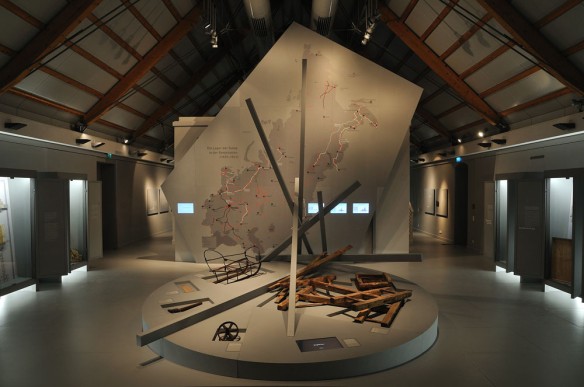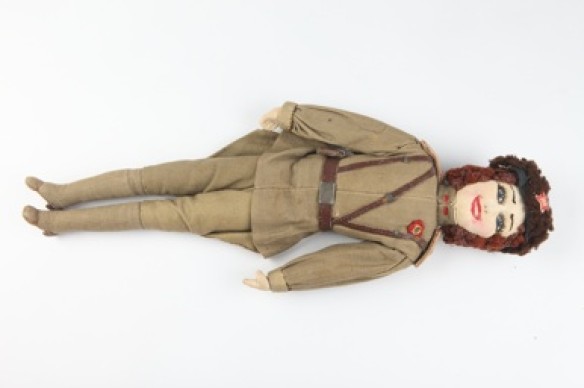In the late 1980s, the staff of “Memorial” began salvaging remnants of the Gulag system from the ruins of former camps. The locations of the camp complexes and their administrations are shown on a large-scale map installed behind the relics of the camps. Three touchscreens embedded in the map offer means of exploring the dimensions of the Gulag with the aid of graphs and diagrams. A further monitor provides basic information on other camp systems in Germany and the Soviet Union. Photo: Claus Bach.
GULAG
TRACES AND TESTIMONIES 1929–1956
OWNER OF THE EXHIBITION
MEMORIAL Society, Moscow, and the Buchenwald and Mittelbau-Dora Memorials Foundation, Germany.
CONTACT PERSON
Dr. des. Julia Landau, Tel: +49 (0) 3643 430 133, jlandau@buchenwald.de. Address: Buchenwald and Mittelbau-Dora Memorials Foundation, 99427 Weimar.
LANGUAGE AND TRANSLATION
At each venue the exhibition will be presented monolingual in the language prevalent in the respective region. Exchangeable graphic elements ensure the necessary flexibility.
FINANCIAL CONDITIONS
The borrower bears the costs of transport, installation, dismantling and architect’s fees for the adaptation of the exhibition to the respective space and the related travel costs. No lending fee is charged.
TECHNICAL REQUIREMENT
The exhibition covers a floor space of 360 square meters minimum. Its installation at each individual venue requires thorough preliminary planning with the curators and designers.
Floor space requirements: Exhibition space min. 360 square metres (plus storage space for transport packaging = 25 square metres).
Ceiling height: min. 6.2 metres clear ceiling height (without map of Soviet Union 4.2 m) Floor load: min. 2.5 kN /sqm.
Other technical requirement. See:
www.ausstellung-gulag.org
www.ausstellung-gulag.org/index.php?id=453&l=1
www.ausstellung-gulag.org/index.php?id=520&l=1
EXHIBITION VENUES
1 May 2012-24 June 2012, exhibition hall of the Neuhardenberg Castle Foundation. 19 August 2012-21 October 2012, Schiller Museum Weimar.


Handmade “Lyubochka” doll, Potma Camp (Mordovian ASSR), 1941. The prisoner Alexandra Stogova made the doll for herself as a reminder of her daughter. While she herself was imprisoned in the camp, her daughter volunteered to fight at the front and earned various high distinctions.
Source: “Memorial” Collection, Moscow. Photo: Peter Hansen

Metal sled for transporting heavy loads, Kolyma Region, 1940s. There were hardly any surfaced roads or paths in the camps in this region.
Source: “Memorial” Collection, Moscow. Photo: Peter Hansen
This travelling exhibition is the first in Germany to present relics of and testimonies to the Soviet camp system collected by the “Memorial” human rights organization all over the former Soviet Union from the 1980s to the present. The exhibition project seeks answers to the following question: How can the Gulag – a penal camp system already described by its contemporaries as the “quintessence” of Soviet tyranny – be described, how can it be comprehended in all of its dimensions? Voices of people who experienced it first-hand and biographies of former inmates accompany visitors on their exploration of this remote archipelago and create a panorama of the Soviet camp system. Objects from the “Memorial” holdings – for example a makeshift bread pouch, a tattered dress or a metal grave tag – make the everyday lives of the camp inmates tangible. The exhibition website presents a selection of significant objects and biographies (www.exhibition-gulag.org).
Companion volume to the travelling exhibition “Gulag. Traces and Testimonies 1929–1956” Published by Volkhard Knigge and Irina Scherbakowa on behalf of the “Memorial” Society, Moscow and the Buchenwald and Mittelbau-Dora Memorials Foundation. The accompanying book to the Exhibition (only in German) can be purchased at the Buchenwald Memorial’s bookshop which can be contacted by phone at +49 (0)3643 430 151 or email at buchhandlung@buchenwald.de.